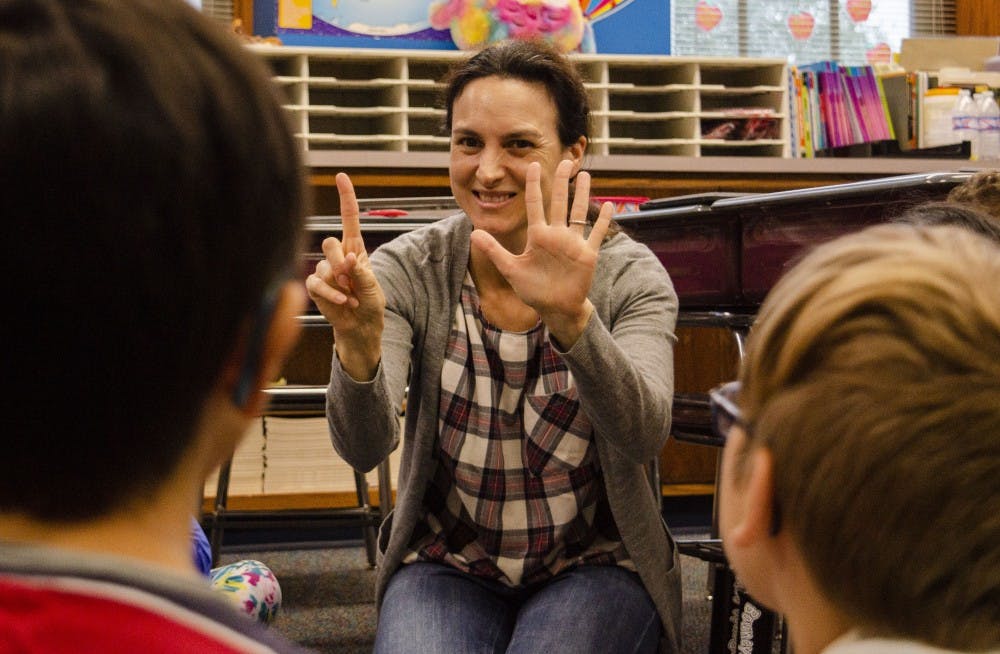One in five U.S. residents speak a different language while they’re at home, according to the Center for Immigration Studies.
However, in most elementary schools, only English is spoken. A new Burris Laboratory School program is seeking to change that.
Spanish assistant professor Stephen Hessel started a program that partners Ball State student volunteers with a Spanish-speaking parent to provide Spanish lessons to children in K-5 at Burris.
Hessel said the program was created last year when his daughter started kindergarten in order to fill a need Burris has.
“[Burris] ended up having the teachers that were teaching the K-5 classes teach more classes at the middle school level,” Hessel said. “Another parent and I started volunteering some Spanish in the kindergarten classroom and I wanted to kind of expand this to all K-5 classes.”
This year, 30 Ball State students and five parents volunteered to teach Spanish to about 264 students, Hessel said. The partners will not only be teaching a different language, but the children will also be exposed to different ethnicities and cultures.
“I think the big thing is showing students at a very young age that there’s cultural difference and people speak different languages here and abroad,” Hessel said. “[It will] help them develop those cultural competencies really early on so that they can understand that not everybody’s going to speak the exact same language, have exactly the same culture.”
To volunteer junior psychological science major Duwon “Wop” Smithson, this exposure to diversity is “very beneficial.”
“You get a great experience from that teacher. For me, I think personally, if I had a black teacher or any ethnically different than white teacher, I would just be excited to learn,” Smithson said. “These students are aware that I’m not just a teacher, I’m a black teacher, and they’ll be very excited to have fun with me.”
Smithson is paired with parent volunteer Paola Carter, who is a native Spanish speaker from Chile. Carter graduated from Temuco Catholic University in Chile with a degree in English and Spanish translation. When she was informed of the program , she thought it would be a good idea.
“I had some experience teaching English to Chilean elementary students. Also, my daughter, who was in second grade back then, asked me if I could teach her class,” Carter said. “I am excited the students show interest in learning a new language, even if it is just the basics.”
Carter and Smithson teach Stefanie Onieal's second grade class, Carter said, and alongside them is senior speech language pathology major Gabriella Hernandez. Hernandez said she joined because of her Spanish 301 professor, Colleen Balukas.
“After looking into it I became very interested and decided it would be a good opportunity that would allow me to gain experience for my future career goals,” Hernandez said. “I absolutely love kids, and I'm excited to get to interact with them, and even learn from them.”
Hernandez said Hispanic populations are rapidly growing in the United States, and this program and others like it would help Latinx individuals feel at home.
“It is so welcoming to encounter people who are putting in the effort to learn part, however small, of your own culture. This will most definitely help integrate the Hispanic community into our community,” Hernandez said.
Apart from an exposure to different languages and cultures, Hessel hopes students discover a passion that they never knew they had.
“Everybody excels in a different way. What’s really cool is when a student finds something what they do excel in academically, and they can kind of get that feedback from that,” Hessel said. “I think one of the most rewarding moments that I saw in the kindergarten class we were working … as we got farther in the semester there were few times where a student who has been struggling, has issues engaging with the other class, we’d ask a question, and that hand would shoot up.”
It’s all about finding the right fit for each student, he said. To Smithson, a child’s mind is open to boundless things, with something destined to fit.
“You can put a lot of bad ideas in children’s heads, but I’m just here to plant great ideas in these young guys' and gals’ heads, especially with learning Spanish and a different language,” Smithson said. “I’m mostly excited about getting these younglings to say, ‘Hola, Señor Wop.’ It’s very funny to me.”
Contact Elena Stidham with comments at emfloyd2@bsu.edu or on Twitter @ElenaStidham.




